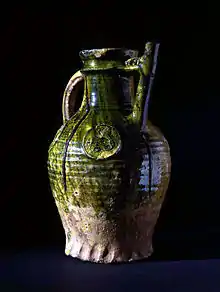York Glazed Ware
York Glazed Ware is a type of Medieval ceramic produced in North Yorkshire, England in the 12th and 13th centuries AD.[1][2]

Production zone
The name 'York Glazed Ware' comes from the initial identification of the type in York,[1] but the manufacturing area is the Hambleton Hills, 30 miles north of York.[1] Production dates from the late 12th to mid-13th centuries AD,[3] after which it was steadily replaced in assemblages by Brandsby-type ware.
Fabric
Although referred to as 'white ware', the fabric can be light brown, light grey or pink.[4] The fabric has an open texture, hackly break, often with sparse to moderate quantities of iron-stained quartz included in the temper.[4]
Form and decoration
The ceramic is usually used to create jugs, some with tubular spouts, some lids, cooking pots, condiment dishes, and aquamaniles.[2] Decorative elements include applied, incised, rouletted or combed types.[4] The most distinctive decoration is applied clay pads stamped with seals,[2] visible on the exterior of large jugs.[1] The glaze is usually green (but sometime yellow), lustrous and almost metallic.[5]
The glaze is coloured green through the addition of copper, giving a shade from "apple green to dark dark green, often with darker speckles".[3]
References
- Jennings, S. 1992. Medieval Pottery in the Yorkshire Museum, York, 18–21.
- McCarthy, M.R. and Brooks, C.M. 1988. Medieval pottery in Britain AD900-1600, Leicester, 233–236.
- Brooks, C.M. Medieval and Later Pottery from Aldwark and Other Sites (Archaeology of York 16/3), York, 151–152.
- Mainman, A. and Jenner, A. 2013. Medieval Pottery from York (Archaeology of York 16/9), York, 1203–1225.
- Holdsworth, J. 1978. Selected Pottery Groups AD 650–1780 (Archaeology of York 16/1), York, 13.